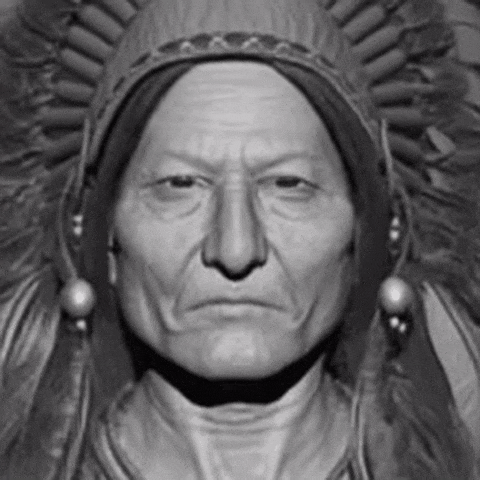PROJECT RESEARCH NOTES
Earlier Camp Notes Posted On Facebook
NOTE # 57: Fungus: The Missing Element to Restoring America's Native Prairie
PUBLISHED:2022-06-11
REFERENCE URL:https://dailyyonder.com/restoring-native-prairie-plants-you-may-be-missing-one-key-ingredient-fungi/2022/06/10/
I am fascinated by fungi! Well, mushrooms and specifically, the ingestible kind. In fact, just this Spring the wine cap (Stropharia rugosoannulata) mushroom spawn that I sowed this time last year began fruiting in the wood chip bed that I created for that purpose. For several glorious mornings in a row, I harvested these large, edible mushrooms, cooking them up and posting the images on my FB account.
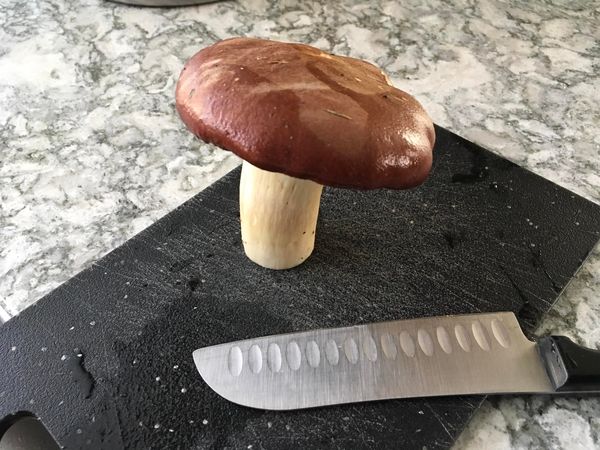
And to be perfectly honest, I am curious (that's all I am since I live in a state where even the medicinal use of cannabis is illegal...for now) about the physiological effects of certain psychedelic fungi (AKA "magic mushrooms"). I also own several mycological tomes by fungi advocate Paul Stamets, so I am sort of "serious" about the these wondrous living organisms.
Now I learn that they are also a vital keystone to the restoration of America's once vast prairie that 160 years of assault by the plow and 70 years of chemical poisoning have decimated.
To quote Daily Yonder (see above link), "The North American prairie once covered 170 million acres, making it the largest ecosystem on the continent, as well as the most biologically diverse. Today, 96% of that prairie is gone. Many property owners and rural communities are seeking to restore native prairie plants, but after years of topsoil loss, pesticides, or invasive plants, they're finding the soil is missing one key ingredient - fungi smaller than a period at the end of this sentence. "
While here are uncountable number of fungi species globally, arbuscular mycorrhizal fungi (AMF) specifically are vital to the health of the native prairie plants.
"In fact, AMF has symbiotic relationships with more than 80% of land plants. They live in the soil and survive by inserting themselves into the plant's roots. From there, they help the plant take up nutrients and water. In exchange, they harvest some of the plant's carbon?the same as a human would after fertilizing and watering a garden."
Tragically, AMF is vulnerable to tilling, sunlight and pesticides, as well as invasive plant species. But if we can restore arbuscular mycorrhizal fungi back into the soil and promote its spread, the result can be impressive, as the comparison image below demonstrates. The plant on the right was treated with AMF while the one on the left was no. The improved vigor of the AMF-treated plant is clearly obvious.

If we're serious about restoring at least some corner of the Great Plains close to its original character -- along with bison -- then the life that is below the ground is just as important is that above.
NOTE # 56: Bison Are Back... with Benefits
PUBLISHED:2022-04-20
REFERENCE URL:https://news.yahoo.com/bison-back-benefits-many-other-201632152.html
Matthew D. Moran, Elbert L. Fausett Distinguished Professor of Biology, Hendrix College, just published an article on the benefits - environmentally and diversity-wise - of the restoration of bison back into their native ranges. After recounting their near-extinction and century-long recovery, he details their role in "Improving prairie landscape."
"Bison feed almost exclusively on grasses, which, because they grow rapidly, tend to out-compete other plants. Bison''s selective grazing behavior produces higher biodiversity because it helps plants that normally are dominated by grasses to coexist.Because they tend to graze intensively on recently burned zones and leave other areas relatively untouched, bison create a diverse mosaic of habitats. They also like to move, spreading their impacts over large areas. The variety they produce is key to the survival of imperiled species such as the greater prairie chicken (Tympanuchus cupido) that prefer to use different patches for different behaviors, such as mating and nesting.
Bison impacts don''t stop there. They often kill woody vegetation by rubbing their bodies and horns on it. And by digesting vegetation and excreting their waste across large areas, they spread nutrients over the landscape. This can produce higher-quality vegetation that benefits other animals.
Studies, including my own research, have shown that bison-induced changes in vegetation composition and quality grazing can increase the abundance and diversity of birds and insects in tall grass prairies. Bison also affect their environment by wallowing ? rolling on the ground repeatedly to avoid biting insects and shed loose fur. This creates long-lasting depressions that further enhance plant and insect diversity, because they are good habitats for plant and animal species that are not found in open areas of the prairie. In contrast, cattle do not wallow, so they do not provide these benefits."
He further notes, "It is hard to determine the ecological role that bison played before North America was settled by Europeans, but available evidence suggests they may have been the most impactful animal on the Plains ? potentially a keystone species whose presence played a unique and crucial role in the ecology of prairies."
Fortunately, this role is increasingly being better understood and appreciated, especially by native tribal and ranching communities alike as demonstrated by a Zoom conference call today on which I eavesdropped, featuring Maggie Hanna with CCALT and Jason Baldes with the Eastern Shoshone Wind River Tribal Buffalo Initiative. With the Denver Museum's Krista Uhlenbrock moderating, they discussed the role of cattle and bison on the grasslands, with Maggie, who also is a cattle rancher and, in her words, wears many hats, noting that grasslands, presumably in North America, are being lost by 4 acres every minute!
Maggie explained that cattle ranchers are beginning to practice rotational grazing as a way to emulate the grazing pattern of bison: intensive grazing for a short period of time followed by a long rest period. Buffalo and the grasslands co-evolved and created a once-flourishing seas of grass that European settlers discovered as they moved west in the early 19th century. By 1900, the bison were gone and so were the grasslands, replaced by crops and cattle. The result has been an estimated loss of nearly 60 billion tons of topsoil, blown away or washed out to sea over the last 160 years!
Obviously that trend simply cannot continue and maybe restoring bison to wildlife status and allowing them to roam free again, as much as is practicable for creating a safe habitable environment for all, man and beast alike, could begin to redress the problem to the benefit of all.
NOTE # 55: Buffalo and America's Failing Rangelands
PUBLISHED:2022-03-15
REFERENCE URL:https://www.hcn.org/articles/north-bureau-of-land-management-there-are-millions-of-acres-of-failing-rangelands-data-shows
High County News recently published an article on the somber findings of an investigation by Public Employees for Environmental Responsibility (PEER) into the health of rangelands under the management of the federal Bureau of Land Management or BLM. The group reports that some 54 million of the 246 acres of mostly western lands under BLM control "fail to meet the agency's own 'land-health standards.'"
While factors like mega-drought, climate change, wildfires, invasive species like cheatgrass, are significant contributing factors, the study concludes that the primary reason is overgrazing by cattle.
PEER's analysis finds that livestock grazing is the primary culprit behind land degradation. The BLM leases more than half of its acreage to ranchers as grazing allotments for cattle, sheep and other livestock. Although everything from drought and wildfire to off-road vehicles can impact rangeland health, livestock grazing is a significant cause of the failing land-health standards of 72% of the public land. That's about 40 million acres.
While grazing too many head of livestock is an obvious factor, it is often theorized that the very grazing habits of domestic cattle leads to rangeland degradation. The obvious question is, are cattle good for the land? According to Nature Conservancy''s Chris Helzer, it depends.
I came across an article he wrote in Prairie Ecologist entitled, "Bison Good, Cattle Bad??" in which he challenges the perception that bison are better for the prairie than cattle. He notes that yes, cattle do tend to literally muddy the water as they like to hang about watering holes more than bison. They also like collect under the shade of trees more. Typically bison will water once a day and drift away from the spring, pond or trough. They also tend to graze on plants differently than cattle, which have been cross-bred - mainly in Europe - over mere centuries for specific traits, muscle and milk, By contrast, bison have, over the millennia, adapted to the harsh conditions of the plains.
After years of bison and cattle observation on the Conservancy's Niobrabra Valley Preserve, Chris concludes...
The differences between [bison and cattle] simply don''t warrant that kind of broad categorization. If grassland conservation is our goal, we should be sure we're open to using whatever strategies (or animals) can help achieve that. In very large prairies, bison may be the best fit -- assuming the logistics and costs of owning bison make sense. In other situations, however, deciding whether bison or cattle are most appropriate is not a simple matter. It's a decision that should be based on facts and management objectives -- not on aesthetics or mythology.To be perfectly honest, until I read Chris' piece, I was prepared to make the case to opening up that "failing" rangeland to bison and let what nature has bred them for to go to work and maybe in a few decades or century, our rangeland might be restored to their pre-barbed wire glory when 19th century authors wrote in awe of the sea of grass and wildflowers that stretched seemingly endlessly before them, a prairie teeming with wildlife, birds and butterflies. After all, I live in a small Nebraska town named in joyous recognition of all the butterflies that early settlers found here. Now they are rare. Maybe more prairie and bison and less pavement and corn is what we need now.
NOTE # 54: ReWILDing European Bison
PUBLISHED:2021-12-06
REFERENCE URL:https://www.rewildingbritain.org.uk/explore-rewilding/reintroductions-key-species/rewilding-superstars/european-bison
When we think of bison, we Americans and likely most other nationalities, tend to view them as the great shaggy beasts that once roamed our Great Plains. They were central of the Plains tribes' culture and economy. Bison bison, their scientific name, were the largest mammals in size and number in North America from the end of the Ice Age to the middle of the 19th century.
But the Great Plains herds of the ''New World'' weren't the only bison roaming the planet. Today, it is believed their progenitors originated in Eurasia, migrating across the now submerged Bering land bridge sometime between 195,000 and 135,000 years ago, eventually competing with the horse and mammoths for grazing range [https://www.nytimes.com/2017/03/13/science/bison-buffalo-north-america.html].
Cave painting in Europe dating back tens of thousands of years depict Bison bonasus or European wood bison, becoming virtually extinct across most of Europe by the Middle Ages, "surviving into the 20th century only in northern-central Europe and the northern Caucasus Mountains."

In the wake of the near extinction of the northern herd during and after World War I, efforts to save the few remaining animals in Poland began in the 1920s. There are an estimated 5,000 head across Europe, about 3,500 in wild and semi-wild preserves. Today it is one of the national animals of Poland and neighboring Belarus.
European bison differ from its distant cousins in North America in that they tend to be taller and somewhat lankier, weighing 1,800 to 2200 lbs compared to the 880 to 2,800 lbs of the American species.
The great antiquity and endangered nature of the European bison also suggests that the ReWILD! blockchain augmented reality game would also be of interest and value in helping raise awareness on that continent as well.
NOTE # 53: How Many Bison Were There Really?
PUBLISHED:2021-10-21
REFERENCE URL:https://www.amazon.com/Twilight-Mammoths-Environments-Paul-Martin/dp/0520252438
When you research the topic of North American bison (buffalo), you usually come across estimates of continent-wide herds totaling between 30-60 million animals. Those numbers are pretty much ''guestimates'' based on anecdotal observations of chroniclers in the 19th century, including Lewis and Clark's Corps of Discovery in the early 1800s where Lewis estimated one herd encountered along the upper reaches of the Missouri at 20,000 animals. Similar numbers where estimated in the late 1860s. However by 1890, the total population of Bison bison numbered probably less than 500 and the majority of those were on a preserve in Canada. Yellowstone had only about 25 animals in the entire park. The reason for such a dramatic population implosion is most often attributed to commercial hide hunters, each of which might kill as many as 4,000 beast in a season.
Paul S. Martin in his book Twilight of the Mammoths argues that the number of bison Lewis and Clark encountered may have been the result of the near extermination of the tribes of North America due to European diseases that are estimated to have taken as many as 95% of the continent's indigenous population: only one-in-twenty survived the ravages of the European disease invasion over a 400 year period. In effect, the drop in human hunting pressure may have allowed a corresponding population explosion among bison, and likely other game animals.
Martin observes (pg 179), "According to Ernest Thompson Seton, early in the nineteenth century, before market hunting began, North America harbored 60 million bison... [however] Seton's extrapolations appear to be based on the assumption that bison were in decline in the early 1800s. In fact, they were on the rise because Native American populations were declining due to exposure to European diseases."
"Even if [indigenous] depopulation were much less severe...it would have considerably diminished human predation pressure on big game...When reported by Lewis and Clark, three centuries after the crisis of [European] contact, bison where thriving as they had not for thousands of years, if ever."
NOTE # 52: Help ReWILD! the Great Plains with 'Virtual' Bison Herds
PUBLISHED:2021-08-28
REFERENCE URL:https://rewildgame.toonstech.com
Perhaps the last gasp of Native American culture was in 1890 and brief emergence of the "Ghost Dance" phenomenon, which ended so tragically - and unnecessarily - with the massacre at Wounded Knee in South Dakota when Army canon fire and rifle shot killed an estimated 250-300 Minconjou Sioux and at least 25 U.S. soldiers, "many likely fallen to friendly fire," says Britannica.
But what was the Ghost Dance? In a way, it was the Native Indian equivalent of the same millenarianism impulse common among many Christian sects: the belief in a "thousand-year age of blessedness" ushered in by the Second Coming of Christ. In the native ghost dancer's view, it not only foresaw the resurrection of their loved ones and ancestors, along with the expulsion of all white men from native lands, but it also envisioned the return of the once-countless herds of buffalo, which by 1890 had been nearly exterminated. A veritable handful were left in Yellowstone and in a few private herds: all totaled, less than 500.
It was the buffalo upon which the Plains tribes, in particular, had built their majestic, but grueling way of life. The buffalo gave them their lodges, the winter robes, many of their daily tools, their meat ration, of course, and perhaps most importantly, they provided the very matrix of their culture. With bison aplenty, they could pursue their centuries-old traditions. Without the vast, nomadic herds, their culture would wither and die. Foreseeing this, many had vainly resisted since the days of the opening of the Oregon trail in the 1840s. Half a century later, the survivors hoped their fervent dancing would usher in that golden age, something few whites understood, especially in the government and Army. For them, the Ghost Dance was the precursor of yet another bloody Indian war.
Knowing this bit of history, it suddenly dawned on me sometime back that by developing what we now call our ReWILD! augmented reality game, we are, in a purely unintentional way, reviving at least one aspect of the ghost dancers' wish: the repopulation - some use the term "rewilding" of the Great Plains with herds of free roaming bison, among other native wildlife. Short of a global catastrophe, that likely will never happen; though it should be pointed out that without constant human intervention, most domestic cattle would not long survive in the wild, especially hard winters of the northern Great Plains. Bison would have no trouble: evolution having engineered them through thousands of years to survive and thrive.
The objective of the ReWILD game is to find, capture, raise, and trade "virtual" bison: think Pokemon GO! or Axie, only way wilder and woolier. In effect, we want players to "breed" millions more bison, digitally, of course. By virtue of caring for virtual animals, we also hope to stimulate interest in the real thing. As an added incentive, each digital bison is also an NFT (non-fungible token) on the cryptocurrency blockchain, which can translate into monetary value on NFT marketplaces. Enterprisingly, Axie players in the developing world are now earning more income from the game than their usual jobs.
Could the same thing happen on America's impoverished Indian reservations as unemployed youth again hunt and trade virtual bison? I'd like to think they could.
Our small team of immersive media technologists have applied for grant funding to develop our phase one MVP App from Project Catalyst. You can help us win a small grant by commenting on the project on the IdeaScale website. Please consider taking a few minutes to register and comment. An "applaud" would be much appreciated.
NOTE # 51: Free the Wild Horses to Rewild the Land
PUBLISHED:2021-08-16
REFERENCE URL:https://www.latimes.com/opinion/story/2021-08-16/climate-change-wild-horses-west
Except from LA Times Op-Ed entitled,"Let wild horses do their part to save the West." It notes that "The Bureau of Land Management, which is responsible for wild horses on federal lands, has rounded up about 50,000 and is warehousing them in government-funded pastures and other locations at a cost of $120 million so far. More than 79,000 horses and about 15,000 burros still roam freely on federal land in 10 states."
We need to let horses have their land back, or at least let them share it with cattle. These are mega-herbivores ? plant eaters that weigh more than 1,000 pounds. North America had plentiful mega-herbivores back in the Pleistocene, including not only Equus species and bison but also mammoths and mastodons. Today, wild horses tend to be the dominant mammal wherever they are and act as sort of ecosystem engineers, creating spaces and opportunities for other species and plants to play their roles in nature.
Unlike cattle, which tear up the roots of grass and clumps of dirt, leaving arid wastelands, horses chomp grass from the top, leaving it to grow back quickly. And they have single-track digestive systems, meaning that grass and other foodstuffs pass quickly through their systems without being as fully digested, as happens in cattle and other ruminants. Horse dung is therefore a key spreader of seeds.
NOTE # 50: Indian Country's Population Growth Proves Erasure Will Not Work
PUBLISHED:2021-08-16
REFERENCE URL:https://nativenewsonline.net/opinion/indian-country-s-population-growth-proves-erasure-will-not-work
While American Indians were not made United States citizens until 1924 through an act of Congress, the Census Bureau in 1900 enumerated the American Indian population as being 237,200. Estimates of the Indigenous population were as high as 112 million in 1492 when Columbus sailed the ocean blue. Other experts say the number was closer to eight million. Regardless, the 1900 Census figure of less than a quarter million convinced those at the turn of the century that the American Indian population would disappear.
This week, the 2020 Census reported that the population of American Indians and Alaska Natives is on the rise, which reminds me of the Mark Twain quote about "the report of my death was an exaggeration."
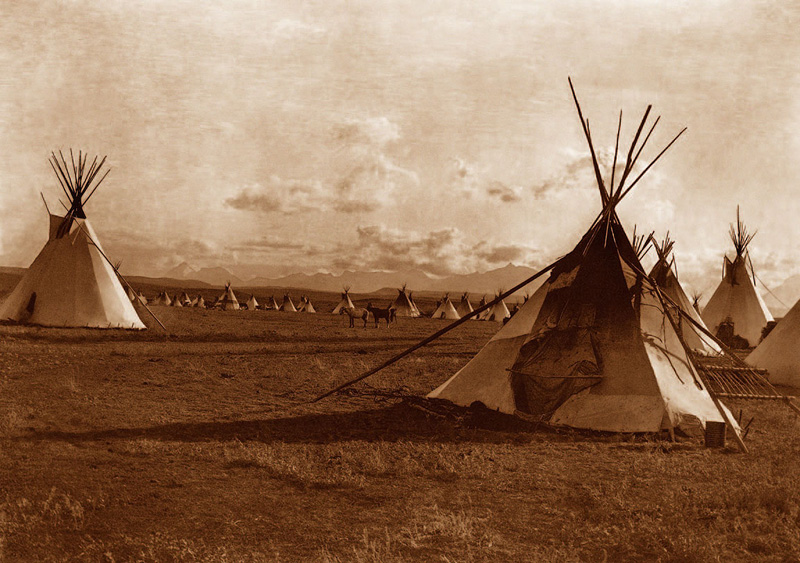
This good news is backed up by data released Thursday showing the American Indian and Alaska Native population, when counted alone and not combined with any other race, was 3.7 million, which is 1.1 percent of the total population of the United States. In 2010, there were 2.9 million American Indians and Alaska Natives. The growth rate over the past decade was a 27.1 percent increase.
NOTE # 49: Geronimo on Preparing an Apache Warrior
PUBLISHED:2021-08-07
REFERENCE URL:https://www.ibiblio.org/ebooks/Geronimo/GerStory.pdf
Came across the Apache leader Geronimo's recollections as recorded in his biography with respect to the tribe's practice of preparing their youth as warriors. The book is also available as a free audio book.
Preparation of a Warrior
To be admitted as a warrior a youth must have gone with the warriors of his tribe four separate times on the warpath. On the first trip he will be given only very inferior food. With this he must be contented without murmuring. On none of the four trips is he allowed to select his food as the warriors do, but must eat such food as he is permitted to have.
On each of these expeditions he acts as servant, cares for the horses, cooks the food, and does whatever duties he should do without being told. He knows what things are to be done, and without waiting to be told is to do them. He is not allowed to speak to any warrior except in answer to questions or when told to speak.
During these four wars he is expected to learn the sacred names of everything used in war, for after the tribe enters upon the warpath no common names are used in referring to anything appertaining to war in any way. War is a solemn religious matter.
If, after four expeditions, all the warriors are satisfied that the youth has been industrious, has not spoken out of order, has been discreet in all things, has shown courage in battle, has borne all hardships uncomplainingly, and has exhibited no color of cowardice, or weakness of any kind, he may by vote of the council be admitted as a warrior; but if any warrior objects to him upon any account he will be subjected to further tests, and if he meets these courageously, his name may again be proposed.
When he has proven beyond question that he can bear hardships without complaint, and that he is a stranger to fear, he is admitted to the council of the warriors in the lowest rank. After this there is no formal test for promotions, but by common consent he assumes a station on the battlefield, and if that position is maintained with honor, he is allowed to keep it, and may be asked, or may volunteer, to take a higher station, but no warrior would presume to take a higher station unless he had assurance from the leaders of the tribe that his conduct in the first position was worthy of commendation.
From this point upward the only election by the council in formal assembly is the election of the chief. Old men are not allowed to lead in battle, but their advice is always respected.
Old age means loss of physical power and is fatal to active leadership.
NOTE # 48: William F. Cody: Man's Man and Staunch Feminist
PUBLISHED:2021-07-29
REFERENCE URL:https://www.amazon.com/Buffalo-Bill-Cody-Behind-Legend/dp/0471077801
From his youth William F. "Buffalo Bill" Cody led a tough life on the western prairie, killing his first Indian in his early teens, culminating in hand-to-hand knife fight with Yellow Hand, a Cheyenne chief in the weeks following the Battle of the Little Big Horn. As a teen, he rode the Pony Express, drove an overland stage, bull-whacked freight trains, was a Union Army scout in the Civil War. He scouted for the Cavalry during the Great Plains Indian Wars, and, of course, led the Royal Buffalo Hunt in 1872.
What you might not expect then is he was also an early feminist. As Robert A. Carter notes in his "Buffalo Bill Cody - The Man Behind the Legend," he was asked by a "prominent" feminist in the 1870s, "Do you believe that women should have the same liberty and privileges that men have?"
"Most assuredly I do," Cody reportedly replied. "I've already said that they should be allowed to vote. Why, of course, if a woman is out earning her living she keeps u[ with what is going on the world, and she knows the best man to vote for…. What we want to do is give our women even more liberty than they have. Let them do any kind of work that they see fit, and if they do it as well as men give them the same pay. Grant them the same privileges in their home life and club life that men have and we will see them grow and expand into far more beautiful and womanly creatures than they are already."
"Cody was not only ahead of their own time but slightly ahead of ours as well. When it comes to earning power, women still have not achieved parity with men."
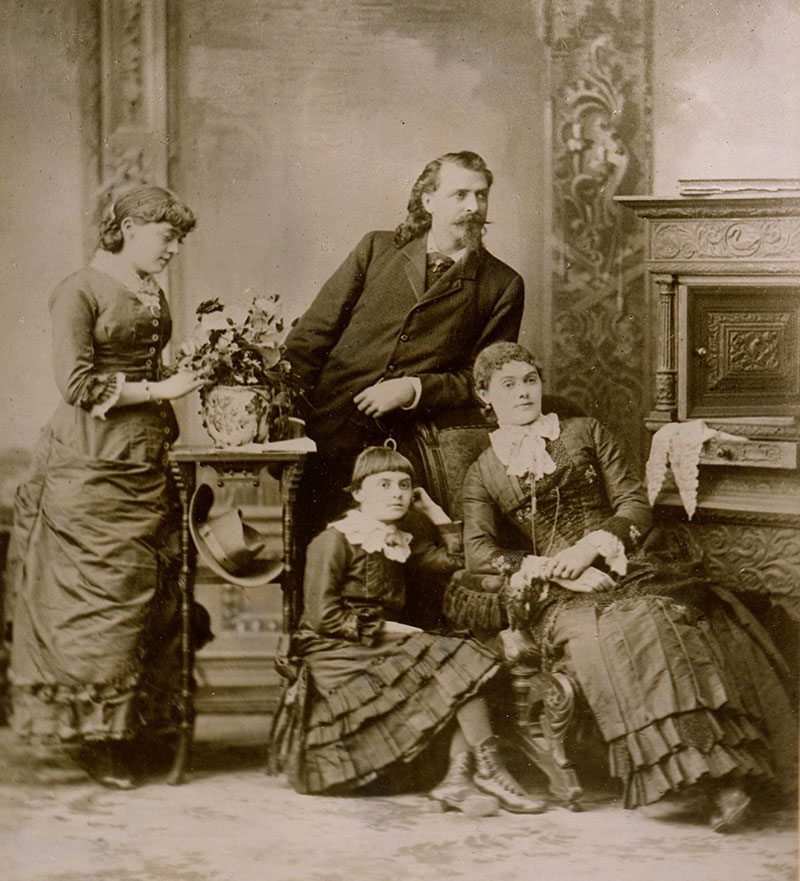
Pictured in Cody with his wife and two daughters
IBID page 289
NOTE # 47: How Much Grazing Land Does the Bureau of Land Management Administer?
PUBLISHED:2021-07-21
REFERENCE URL:https://tinyurl.com/blmgrazingland
As part of the LBBR AR mobile game development, I need to know how much federal grazing lands the Bureau of Land Management (BLM) manages and how many bison could theoretically graze that land at 5 acres per animal. The answers are 155 million acres and 31 million bison, respectively.
The BLM manages livestock grazing on 155 million acres of those lands. The terms and conditions for grazing on BLM-managed lands (such as stipulations on forage use and season of use) are set forth in the permits and leases issued by the BLM to public land ranchers.
The BLM administers nearly 18,000 permits and leases held by ranchers who graze their livestock, mostly cattle and sheep, at least part of the year on more than 21,000 allotments. Permits and leases generally cover a 10-year period and are renewable if the BLM determines that the terms and conditions of the expiring permit or lease are being met. The amount of grazing that takes place each year on BLM-managed public lands can be affected by such factors as drought, wildfire, and market conditions.
NOTE # 46: Effect of Virtual Reality Perspective - Taking on Related and Unrelated Contexts
PUBLISHED:2021-07-19
REFERENCE URL:https://www.stanfordvr.com/topics/empathy-diversity/
Virtual reality perspective-taking (VRPT) experiences effectively increase both empathy and prosocial behaviors toward related social targets (e.g., cutting down a tree in virtual reality increases concern for the environment). This project tests the prediction that empathy is analogous to a muscle that increases with practice and can transfer to unrelated contexts instead of being a mental state that increases only for a specific context or target. This study examines the extent to which VRPT experiences can train empathic skills that are applied to unrelated social targets and contexts. Two thirds of the participants engaged in VRPT experiences either showing what it is like to become homeless or how ocean acidification affects the marine environment. A third of the participants were in the control condition and did not complete a VRPT task. Results replicate previous findings showing that VRPT tasks increase related context empathy and prosocial behaviors; however, the results on VRPTs effect on empathy and prosocial behaviors for unrelated contexts were mixed. The VRPT ocean acidification task was more effective at inducing empathy for the homeless, an unrelated social target, than the control condition, but the empathy-transfer effect did not occur from the homeless context to the ocean context. Replicating previous work, participants who experienced what it is like to become homeless signed a petition supporting the homeless at significantly higher rates than participants in the control condition. These findings show that transfer of empathy from one context to another is possible, but this transfer does not occur for all contexts.
Virtual Human Interaction Lab Publications -- Stanford University
NOTE # 45: Of Wildebeest and Bison: Keystone Species of the Plains
PUBLISHED:2021-07-18
REFERENCE URL:https://www.youtube.com/watch?v=i8wrAkixfHc
I have noted previously a comparison between North American bison and African wildebeest, especially as analogs to what the Great Plains might have been like when millions of buffalo roamed free. Well, turns out I wasn't the only one as this wonderful "In Our Nature" documentary makes plain.
NOTE # 44: Migratory Range of Camp 1872's "Alpha" Herd
PUBLISHED:2021-07-17
REFERENCE URL:https://tinyurl.com/yellowstoneherd
In starting to plot out "game play" for the bison hunt AR game, I need to understand what the typical migratory pattern is for wild bison. Here the Yellowstone Park herd is somewhat instructive. This from the NPS website:
"Bison are mostly active during the day and at dusk, but may be active through the night. They are social animals that often form herds, which appear to be directed by older females. Group sizes average about 20 bison during winter, but increase in summer to an average of about 200, with a maximum of about 1,000 during the breeding season (known as the rut) in July and August. Bison are sexually mature at age two. Although female bison may breed at these younger ages, older males (>7 years) participate in most of the breeding.
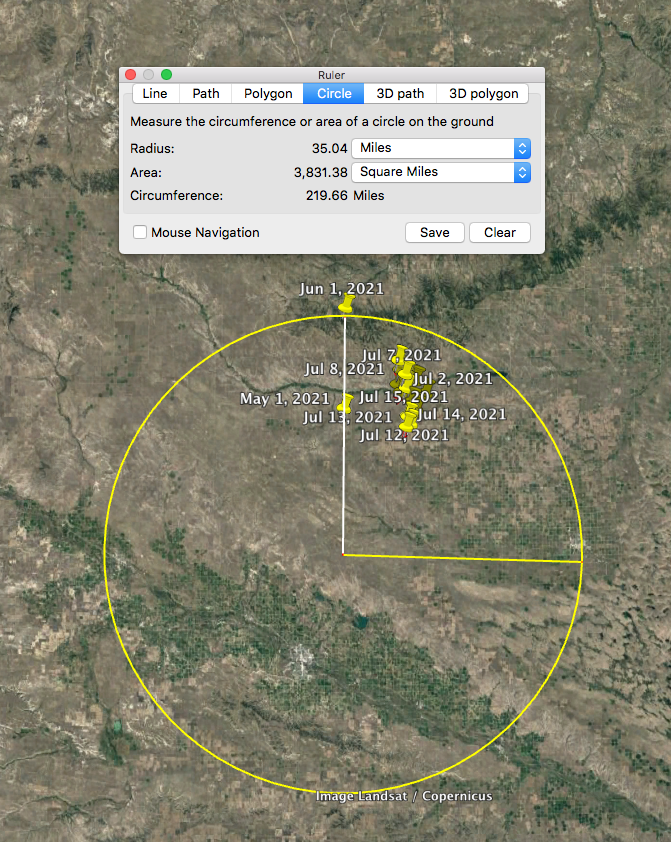
The above screen capture of our virtual "Alpha" herd shows their movement in this Spring and into early Summer. Since bison are migratory based on the seaon of the year, 70 miles would take them well south of the Platte River in winter. Of course we have no records of the movement of the wild herds of the 1800s and earlier. How far did their groups and larger herds move from season to season?
Today the closest analog might be the wildebeest of Africa.
"Every year, more than one million wildebeest and 200,000 zebras complete this 480-kilometer (300-mile) migration loop.This might represent a circle with a circumference of 300+ miles and radius of 50 miles, about 45% larger than the Yellowstone herd, which is restricted by the park's topology and boundaries. On an open plains, the area of the migration could be comparable to that in Africa.
NOTE # 43: Animated Animals: Can Games Engage an Audience with A Conservation Message?
PUBLISHED:2021-07-16
REFERENCE URL:https://news.mongabay.com/2017/07/animated-animals-can-games-engage-an-audience-with-a-conservation-message/
Turns out, as Ecclesiastes 1:9 states, "there is nothing new under the sun." Our idea to create an augmented reality geolocation game to find, capture, raise and trade virtual 3D bison in augmented reality has a predecessor by a good five years. It's called Safari Central. It focused on African wildlife. Like our "Little Big Buffalo Hunt," it's ultimate objective is to engage players in a deeper appreciation of the importance of wildlife conservation.
Writing in a July 2017 article for Mongabay, the late Sue Palmenteri noted:
"As technology for data analysis and visualization improves, online gaming could turn out to be a valuable tool for conservation education, advocacy, and funding. Its role in promoting positive change for nature and humanity has been debated, and its potential in helping biodiversity conservation even formally researched. However, this potential has not yet been fully realized, despite games'' global popularity.
The games market is enormous: more than 2 billion people play video games worldwide. Newzoo's latest Global Games Market Report estimates that game revenues reached nearly US $100 billion in 2016, mostly from digital games. The report expects mobile (smartphone and tablet) gaming alone to generate $46 billion in 2017.
In the United States, consumers spent more than $23 billion in 2015 on games, $16 billion in content alone, despite the relative low cost of digital games, which often cost less than $5. Over 150 million Americans play video games, yet fewer than one-third of adult millennials in a Pew Research Center survey considered themselves environmentalists.
As the article speculates, "Though still unproven, games also offer an unconventional business model to support wildlife conservation programs through small in-game purchases by a potentially huge audience."
NOTE # 42: Where Virtual Bison (May) Roam : Possible Beta Game Test Locations
PUBLISHED:2021-07-15
REFERENCE URL:https://stacker.com/stories/4883/major-cities-most-accessible-public-parks
Below are the top 10 US urban communities with the most area of public parks and recreation areas by population.
#10. Chicago, Illinois
- Park access rating: 98 out of 100<br>
--- Residents who live within a 10-minute walk of a park: 98% (78.2% above national average)
- Park acreage rating: 33
--- Share of city land used for parks/recreation: 10% (33.3% below national median)
--- Total parks in the city: 1,232
- Park investment rating: 100
- Park amenities rating: 73</p>
#9. Boston, Massachusetts
- Park access rating: 100 out of 100
--- Residents who live within a 10-minute walk of a park: 100% (81.8% above national average)
- Park acreage rating: 49
--- Share of city land used for parks/recreation: 17% (13.3% above national median)
--- Total parks in the city: 930
- Park investment rating: 92
- Park amenities rating: 65
#8. San Francisco, California
- Park access rating: 100 out of 100
--- Residents who live within a 10-minute walk of a park: 100% (81.8% above national average)
- Park acreage rating: 54
--- Share of city land used for parks/recreation: 21% (40.0% above national median)
--- Total parks in the city: 471
- Park investment rating: 100
- Park amenities rating: 62
#7. Irvine, California
- Park access rating: 73 out of 100
--- Residents who live within a 10-minute walk of a park: 82% (49.1% above national average)
- Park acreage rating: 78
--- Share of city land used for parks/recreation: 27% (80.0% above national median)
--- Total parks in the city: 127
- Park investment rating: 100
- Park amenities rating: 67
#6. Portland, Oregon
- Park access rating: 85 out of 100
--- Residents who live within a 10-minute walk of a park: 90% (63.6% above national average)
- Park acreage rating: 69
--- Share of city land used for parks/recreation: 18% (20.0% above national median)
--- Total parks in the city: 328
- Park investment rating: 100
- Park amenities rating: 65
#5. Cincinnati, Ohio
- Park access rating: 74 out of 100
--- Residents who live within a 10-minute walk of a park: 82% (49.1% above national average)
- Park acreage rating: 56
--- Share of city land used for parks/recreation: 14.% (6.7% below national median)
--- Total parks in the city: 306
- Park investment rating: 100
- Park amenities rating: 93
#4. Arlington, Virginia
- Park access rating: 99 out of 100
--- Residents who live within a 10-minute walk of a park: 99% (80.0% above national average)
- Park acreage rating: 38
--- Share of city land used for parks/recreation: 11% (26.7% below national median)
--- Total parks in the city: 181
- Park investment rating: 100
- Park amenities rating: 89
#3. St. Paul, Minnesota
- Park access rating: 99 out of 100
--- Residents who live within a 10-minute walk of a park: 99% (80.0% above national average)
- Park acreage rating: 53
--- Share of city land used for parks/recreation: 15% (0.0% below national median)
--- Total parks in the city: 264
- Park investment rating: 100
- Park amenities rating: 78
#2. Washington D.C.
- Park access rating: 98 out of 100
--- Residents who live within a 10-minute walk of a park: 98% (78.2% above national average)
- Park acreage rating: 55
--- Share of city land used for parks/recreation: 24% (60.0% above national median)
--- Total parks in the city: 631
- Park investment rating: 100
- Park amenities rating: 80
#1. Minneapolis, Minnesota
- Park access rating: 98 out of 100
--- Residents who live within a 10-minute walk of a park: 98% (78.2% above national average)
- Park acreage rating: 64
--- Share of city land used for parks/recreation: 15% (0.0% below national median)
--- Total parks in the city: 269
- Park investment rating: 100
- Park amenities rating: 79
NOTE # 41: Chance of White Buffalo Calf Being Born
PUBLISHED:2021-07-13
REFERENCE URL:https://www.washingtonpost.com/archive/politics/2007/01/07/white-buffalo-calves-though-rare-are-becoming-less-so-span-classbankheadanimals-are-sacred-to-native-americansspan/eaa9b41a-2dc3-4e02-b50a-9e8667ba8d40/
"Dave Carter, executive director of the National Bison Association in Colorado, said the chance of a pure white buffalo birth remains as high as 1 in a million."
"Scientists say three things in nature can cause this kind of spontaneous genetic mutation: radiation, chemical exposure and a natural accident in the process of the cell duplicating DNA."
NOTE # 40: Virtual Bison Herd Growth Projection
PUBLISHED:2021-07-12
REFERENCE URL:https://calculator.academy/population-growth-calculator/#f1p0
According to the population growth calculator on the Calculator.academy website, if we want to set our static population to 25 million virtual bison after 20 years with a steady growth rate of 15%, we would need to 'mint' 1.5 million smart(r)* smart contract 'Bisontokens' for our Initial Token Offering (http://bisontoken.io).
* A "smart(r)" smart contract is modifiable as new meta data is collected from decentralized oracles and "envisioned" SingularityNET A.I. nodes to give the "virtual" bison the ability to react to environmental changes.
NOTE # 39: BISON BY THE NUMBERS : National Bison Association
PUBLISHED:2021-07-12
REFERENCE URL:https://bisoncentral.com/bison-by-the-numbers/
Data & Statistics
183,780: Number of bison in the United States residing on private ranches and farms according to the 2017 USDA census.
1,775: Number of private U.S. ranches and farms raising bison according to the 2017 USDA census.
119,314: Canadian private-bison herd size according to 2016 Canadian Census of Ag.
9,855: Approximate number of bison in US federal herds (DOI 2014)
9,008: Bison in State and other Public herds (USFWS 2011)
20,000: Estimated bison on tribal lands
362,406: Estimated herd size in North America today.
30 ? 60 Million: Estimated North American herd size prior to 1600.
Less than 1,000: Estimated number of bison prior to 1900 before efforts were made to preserve and restore the species.
69,000: Approximate number of bison harvested in the U.S. and Canada in 2020. (By contrast US Beef slaughters about 125,000/day).
63,056: 2020 U.S. bison harvest under federal inspection. State-inspected slaughter adds approximately 15% to the total number of bison harvested in the U.S.
19,447: harvest-ready Canadian bison imported to the U.S. in 2020
5,127: Canadian feeder bison imported to the U.S. in 2020
270-285: gestation period in days for a bison cow.
40-50 pounds: approximate weight of a new born calf.
20 years: average reproductive life span of the average bison cow.
20-30 months: age of a mature meat animal.
2.42: grams of fat in a 100 gram serving of cooked bison.
10.15: grams of fat in a 100 gram serving of cooked beef.
NOTE # 38: Cody's State-of-the-Art Stage Magic
PUBLISHED:2021-07-02
REFERENCE URL:https://www.goodreads.com/book/show/8822053-buffalo-bill-cody
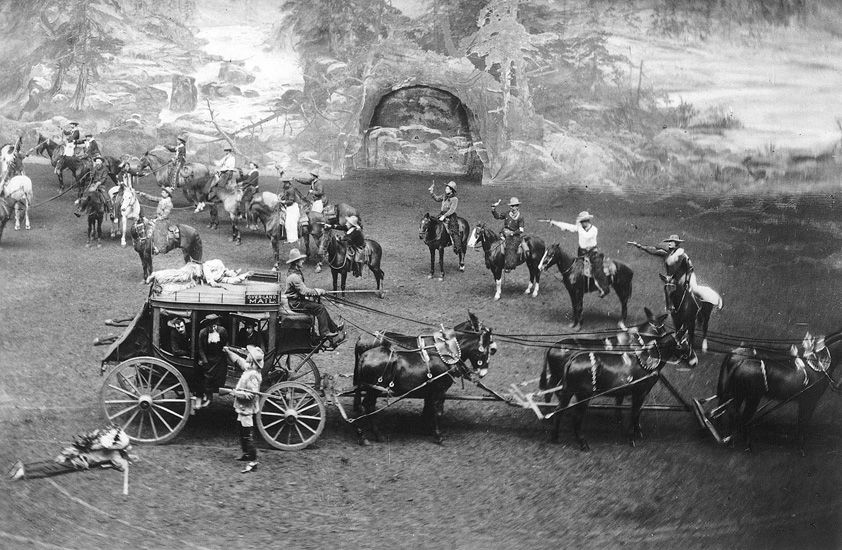
When Col. Bill Cody's Wild West Show moved from London to Manchester, England early in the winter of 1887, he spent some $40,000, the equivalent today (2021) of more than $1.145 million USD to build the scenery for the show entitled "Depiction of American Pioneer History" that included seven panoramas, each two hundred feet long, operated on drums thirty feet high.
"The Manchester Sunday Chronicle applauded the installation: 'The theater, brilliantly lighted [by electric lumination] and warmed [by steam] throughout, is like nothing else ever constructed in this country?. The illusion, indeed, is so well managed and complete, the boundless plains and swelling prairies are so vividly counterfeited, that it is difficult to resist the belief that we are really gazing over an immense expanse of country from some hillside in the far West. The pictures? are singularly beautiful in themselves? Buffalo Bill has come, we have seen, and he has conquered.'"
Page 323, Buffalo Bill Cody - The Man Behind the Legend, Carter, R.A.
NOTE # 37: William T. Sherman: Manifest Destiny Personified
PUBLISHED:2021-07-02
REFERENCE URL:https://www.goodreads.com/book/show/8822053-buffalo-bill-cody
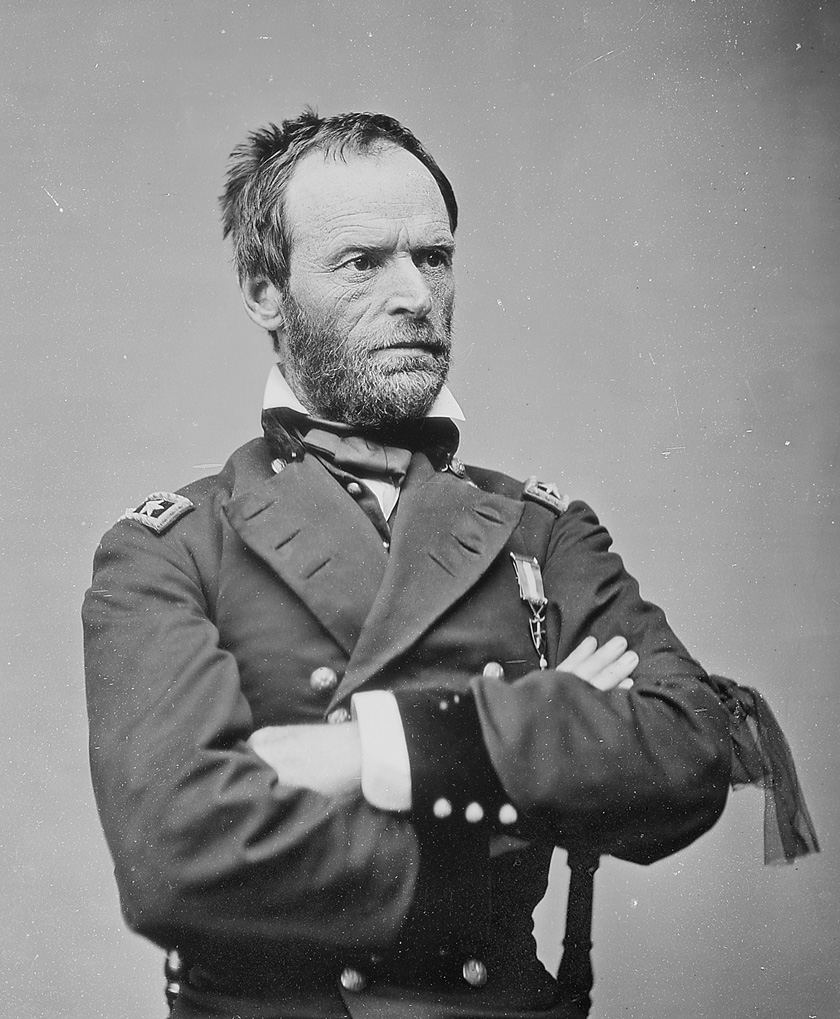
William T. Sherman, the US Army general who is credited with initiating the modern concept of "total war," penned the note below in 1888 upon Bill Cody and his Wild West Show's triumphant return from Great Britain. It is instructive of mindset of the author of the largely unspoken strategic plan to deny the 'enemy' - in this case the Plains Indians -- of their economic base, the vast herds of buffalo that roamed the grasslands of the Dakotas to Texas. The source is Robert A. Carter's Buffalo Bill Cody - The Man Behind the Legend.
Dear Sir -- In common with all your countrymen, I want to let you know that I am not only gratified but around of your management and success. So far as I can make out, you have been modest, graceful, and dignified in all you have done to illustrate the history of civilization on the continent during the past century?
As nearly as I can estimate, there were in 1865 about nine and one-half million buffaloes on the Plains between the Missouri River and the Rocky Mountains; all are now gone, killed for their meat, their skins and their bones. This seems like a description, cruelty, and murder, yet they have been replaced by twice as many cattle. At that date there were about 165,000 Pawnees, Cheyenne, and Arapahoes, who depended upon these buffalo for their yearly food. They, too, have gone, but they have been replaced by twice as many white men and women, who have made the earth to blossom, and how can, be counted, taxed, and governed b the laws of Nature and civilization. This change has been salutary, and will go on to the end. You have caught one epoch of this country's history, and have illustrated in the very heart of the modern world ? London ? and I want you to feel that on this side of the water we appreciate it.
This drama must end; days, years, and centuries follow fast; even the drama of civilization must have an end. All I aim to accomplish on this sheet of paper is to assure you that I fully recognize your work. The presence of the Queen, the beautiful Princess of Wales, the Prince, and the British public are marks of favor which reflect back on America sparks of light which illuminate many a house and cabin in the land where once you guided me honestly and faithfully, in 1865-66, from Fort Riley to Kearney, in Kansas and Nebraska.
Sincerely your friend,
W.T. SHERMAN
NOTE # 36: New-born Bison Calves @ Cross Timber Bison
PUBLISHED:2021-07-02
REFERENCE URL:https://www.youtube.com/watch?v=h2rkLtyJE_Q
For future 3D animation reference when Little Big Buffalo Hunt goes live as our augmented reality geolocation "hunt, capture, raise and trade" mobile game.
NOTE # 35: How Many Bulls to Breed Bison Herd?
PUBLISHED:2021-06-25
REFERENCE URL:https://www.youtube.com/watch?v=qTP5gQ_GefQ
Dusty Baker is the owner of Cross Timbers Bison Ranch in Oklahoma. He runs a nice Youtube channel featuring his bison herd, from which I've learned a lot. This particular video was from his recent visit to another, even larger 12,000 acre (18.75 sq mi) bison ranch south of Oklahoma City with some 450+ bison. What I found valuable in this one are his comments about the ratio bulls to cows, which turns out to be 64 cows to each bull. By keeping their seven breeding bulls with the herd, they increased the breeding rate from the low 70% to more than 90%. Also, Dusty noted that a healthy bull typically can cover 25 cows, so those seven bulls have their work cut out for them as we enter breeding season, which starts in July and can go through October. Here's the relevant except from Dusty's video.
NOTE # 34: 19th Century Retreat of America's Bison Herds
PUBLISHED:2021-06-20
REFERENCE URL:https://www.digitalcommonwealth.org/search/commonwealth:ht250279n
Came across this map showing the range of bison from 1800 to the 1880s. By the 1890s there were only some two dozen bison left under federal protection in the Yellowstone park area and comparable number in small herds in Montana and Texas.
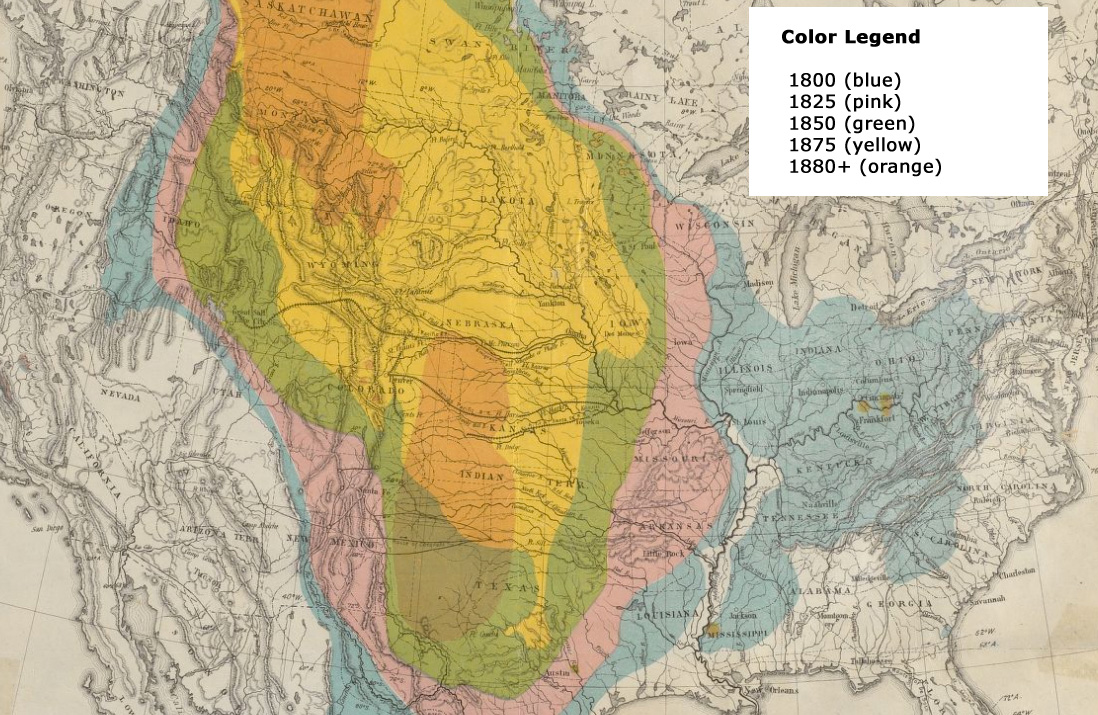
NOTE # 33: Cardano's Hoskinson: "We'll do crypto bison"
PUBLISHED:2021-06-19
REFERENCE URL:https://youtu.be/W85N7qqXHGA
Cardano founder and Wyoming bison ranch owner Charles Hoskinson sat down with podcaster Lex Fridman for nearly 5 hours to talk about cryptocurrency, the blockchain, and the future of video games. I excerpted two portions of that interview that seem relevant to the goals of the CAMP1872 Xperience roadmap: creating digital bison that are locked to the Cardano blockchain, giving them transferability and (hopefully) economic value. It is these 3D bison that players attempt to find, capture, raise - if they wish - and trade in the Little Big Buffalo Hunt AR mobile game.
At the 9:24 mark in this 17-minute excerpt, Hoskinson tells Fridman, "we'll do crypto bison." Since I have a funding proposal into the Cardano Foundation's Catalyst Project to do just this, hopefully it'll be one of our bison that he gives to Fridman.
NOTE # 32: Sharing Bisontoken Idea with Cardano Foundation
PUBLISHED:2021-06-18
REFERENCE URL:https://www.youtube.com/watch?v=ilf8NMUU0yg
The Cardano Foundation, through their Project Catalyst program, gave me the opportunity to do an Open Mic presentation on the idea to create an augmented reality mobile game App where we "mint" 3D animated bison/buffalo as non-fungible tokens on the Cardano blockchain. They recorded my presentation, one of a half dozen or so and I was able to grab it and edit out my portion for your "enjoyment" (?). Hopefully, it's clear what I am aiming to accomplish and certainly big thank you to the Foundation for the chance to share the idea.
NOTE # 31: Bison Genetics: Which Gene Does the Offspring Inhert?
PUBLISHED:2021-06-02
REFERENCE URL:https://academic.oup.com/jhered/article/112/2/174/6141414
Our genes typically manifest a particular set of characteristics that tend to run in "families." These groupings are called "haplotypes." A study of 25 randomly selected bison from the Yellowstone herd recognized 10 distinct haplotypes. What happens to those haplotypes when a bull of one type breeds with a cow carrying a different haplotype? Does the offspring share half of each or does one dominate?
To better understand that question, semen was collected from a Yellowstone bull and 5 ova from a Semmental cow, which were then fertilized and placed in 5 donor cows. After some weeks, a fetus was removed and lung tissue samples taken. These were then analyzed for their haplotypes. Here is the result of that study:
"We used GenomeScope to fit the k-mer count histograms for each of the parents and the F1 hybrid fetus in order to estimate heterozygosity. This yielded heterozygosity estimates of 0.45% for the bison sire, 0.44% for the Simmental dam, and 1.46% for the hybrid (Supplementary Figure S1). "
So, it would appear they are shared, at least that''s my layman''s reading of the results. Corrections appreciated.
NOTE # 30: How to Grow Digital Bison
PUBLISHED:2021-05-27
REFERENCE URL:
In the CAMP1872 Xperience's quest to give everyone the opportunity to interact with both real world and digital 3D bison, the challenge is to not only find ways to mirror the responses of a real bison herd in the wild world into a virtual world (see our Alpha Herd) but to integrate the digital herd into the rapidly evolving crypto blockchain world in the form of non-fungible tokens (NFTs). These assets can be traded, moved from one "owner/custodian" to another and typically held in what is referred to as "wallets." Once an NFT is moved on the blockchain from one wallet to the next that data becomes "immutable," effectively freezing the status of that asset, which is fine for crypto art, but not for a virtually "living" bison that needs to move to fresh grazing, its weight and health changing on a more-or-less daily basis. We would need to find a way to expose each bison NFT to its virtual world, while not jeopardizing custodianship.
The question is not how to do this, but is it even feasible?
Turns out it appears to be quite feasible, as Kyle Johns points out in the reply below. I "met" him online during a Cardano presentation. And while his comments are generally above my pay grade in terms of understanding, it's reassuring that it can be done. Here's his comment:
Hey Bill,
First off thank you for reaching out! I definitely have some thoughts on your idea.
1) You could use IPFS + Metadata and Json-LD. Ultimately every time you run your algo you dump your results into a json file that is pushed onto IPFS. This file's hash can then be put into metadata for a Cardano transaction. Unsure exactly how you're doing the NFT aspect but you could use IPFS for the static info of the Bison. This would also result in the bison having a unique hash which you could reference in your algo(rithm) result file. You would need a way to communicate which is the latest result file but this could be done via a registry. This will allow you to reference bison associated with NFTs regardless of ownership.
...hopefully this was helpful.
So, effectively, each virtual bison continues to "live", moving with its associated herd, exposed to the same environmental and biological factors.
NOTE # 29: Bison: Not Your Father's Bovine
PUBLISHED:2021-05-18
REFERENCE URL:https://www.thewildlifenews.com/2020/09/02/bison-ecology-ecological-influence-behavior-and-decline/
Came across an illuminating paper on "Bison ecology," one that looks not only at their interaction with the environment - as the quotations below indicate - but also how native tribes utilized them as an economic resource and may have been as responsible, or more, for their near extinction as white invaders. Check the reference for more details. Also track the movement of our Alpha Herd.
Many studies have documented the more persistent movement of bison compared to cattle. Van Vuren (1979, 1983) studying bison in the Henry's Mountains of Utah reported that an introduced herd of wild bison differed from cattle using the same ranges in several notable ways. Bison tended to stray further from water sources, used steeper terrain and higher elevations than cattle. Van Vuren also noted that bison seldom stayed in one location more than 3 days.
Even where habitat variation is low, bison seem to wander widely and Lott and Minta (1983) characterized bison as "highly mobile" animals. According to Lott (1991) who has studied free-roaming bison introduced to Catalina Island in California, bison had much larger home ranges than nearly all species of African ungulates, except for during migration periods. For example, water buffalo which are approximately the same size as American bison, have home ranges about 5% of the bison on Catalina Island, even in drought periods (Lott, 1991).
Carbyn and his colleagues (Carbyn et al. 1993) commented that wood bison in Canada often moved up to 32 km over a short period of time "for no apparent reason".
Norland, (1984) studying bison in Theodore Roosevelt National Park, noted that animals seldom stayed in the same location for more than 48 hours and characterized them as being "highly mobile, moving to new localities and habitats almost daily." Norland concluded that due to the constant movement and random nature of these movements that plants were "potentially grazed only once, if at all, in a 3-4 week period".
Meagher (1989) noted that though bison may have strong fidelity to home territory, they do make sudden movements of considerable distance.
Such sudden movements were noted by many early travelers on the plains as well. Along Wyoming's North Platte River in 1834 John Kirk Townsend (1978) commented that "buffalo still continue immensely numerous in every direction, and our men kill great numbers…". But the next day he wrote, "When we rose this morning, not a single buffalo, of the many thousands that yesterday strewed the plain, was to be seen. It seemed like magic. Where could they have gone? I asked myself this question again and again, but in vain."
Not only do bison move more frequently than cattle, but their selection of habitat within the landscape is also different (Kohl 2013). In northern Colorado, Peden et.al. (1974) found that bison spent less time near water and only watered once a day. Similarly, Norland (1984) reported that bison would go to water once a day. The length of stay at watering areas was "short duration–one hour or less for even the largest herds". In both studies, it was noted that bison appeared to prefer drier forage, spent less time in swales and depressions where soil moisture was higher than might be expected.
NOTE # 28: Droughts & Seasons: Tweaking Migration Algorithm
PUBLISHED:2021-05-17
REFERENCE URL:https://www.drought.gov/states/nebraska/county/dawes
From time long-forgotten, bison have roamed much of the North American continent. While much of the megafauna with whom they shared the grasslands, forests, and mountains went extinct some twelve or more millennia ago, bison survived, perhaps because of their innate ability to move across the land. They could migrate seasonally, always in search of fresh grass and forb each Spring.
Similarly, our virtual Alpha Herd of 36 virtual bison: heifers, yearlings and bulls, is electronically migrating across the Nebraska Sandhills in Dawes County (below map point), which is currently in a "moderate drought" condition. To the east in Cherry County conditions are better and further east and south, conditions are normal. So, we're tweaking the code that controls their movement by taking into consideration the time of the year and local drought conditions away from which we want them "naturally" moving.
We'll see how "they" respond: (hopefully) they'll move away from the drought and towards greener grass to the east.
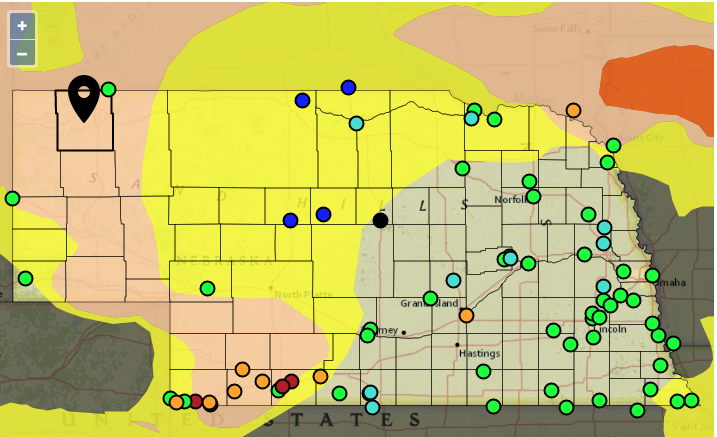
NOTE # 27: Creating a Virtual 3D Bison
PUBLISHED:2021-05-13
REFERENCE URL:https://platige.com/project/commercial-branded-content/zubr-22/
Poland-based digital arts studio Platige Image! created this amazingly life-like bison for a series of television commercials. This is the technology what I hope we can utilize for the CAMP1872 Xperience that would utilize a herd of similar digital facsimiles in our Augmented Reality production that takes participants along with Bill Cody, Spotted Tail, Grand Duke Alexis and George Custer out onto the rugged eroded Buffalo grasslands of southwest Nebraska 150 years ago.
NOTE # 26: Calculating Grazing Needs of the Alpha Herd
PUBLISHED:2021-05-12
REFERENCE URL:https://www.fws.gov/refuge/arctic/carcon.html
At the moment, with one more calf (aka 'red dogs' for their reddish pelage) programmed to be born yet this month, the Alpha Herd consists of 35 virtual bison, each of which it is estimated requires some 5 acres of pasture for grazing. So, the question is, how big a square does that represent, assuming bison graze inside a square. In the wild it's probably more a ellipse as they moved along. But if it were a square it would be one approximately 2,750 feet on a side, representing a total of some 175 acres, or just over one-quarter of a standard 640 acre section. If we use migrating North American caribou as a model for how wild bison might have traveled, here what we know about their migrating and feeding patterns.
"Caribou herds migrate different distances. Large herds are more apt to migrate long distances, while smaller herds often migrate shorter distances. For example, the Porcupine caribou herd, which contains about 218,000 animals, migrates between summer and winter ranges that are about 400 miles apart. The Central Arctic herd, which contains about 30,000 animals, migrates between summer and winter ranges that are about 120 miles apart.
"Biologists have discovered, by using satellites to track caribou, that the herds actually travel much farther than the straight-line distance between summer and winter ranges would indicate. They move to and fro over a wide area, adding many miles to their journeys. Porcupine Caribou herd animals, for example, have been observed to travel over 3000 miles per year."
NOTE # 25: Barometric Pressure Changes and Bovine Movement
PUBLISHED:2021-05-11
REFERENCE URL:http://www.aloki.hu/pdf/1404_149158.pdf
A colleague raised the question as to whether or not I had included the influence of weather, barometric pressure in particular, into my the algorithm controlling the movement of the Alpha herd. The short answer is no, but it got me to wondering if cattle, likely including wild bison, are affected by changing pressure heralding changes in weather (moisture, temperature, etc.) Turns out there's a paper written on the results of research into this question on a herd of domestic cattle in Hungary; the link to the PDF is above. Their research conducted over some four years can be summarized thus:
"As rising atmospheric pressure has a calming effect on cattle, cows walk their normal daily route and spend about 8 hours feeding, and walk about 6 km on normal, nonstressed days. However, as the pressure starts to decline, the herd shortens its daily walked distance significantly or does not move at all if a stress-causing warm front is above them..."
"Solar radiation, atmospheric pressure, maximum temperature, wind speed and relative humidity determine the outdoor comfort level, as Yin (2011) suggested that a strong relationship may exist between microclimatic and comfort conditions... Results show that warm-weather fronts – low atmospheric pressure ( ) may cause more stress, because the changing (dropping) atmospheric pressure has an effect on the parasympathetic nervous system (Hainsworth et al, 2007; Kovacs, 2010). Warm-weather fronts are often accompanied by high temperature and humidity. Relaxed cattle spend more time by grazing (Grandin, 1980). Seeking fresh, nutritious grass is a natural herbivore behaviour (Gere, 1977), therefore a non-stressed herd's pasture activity is 80 % grazing and ruminating. Stressed animals gather in one group and spend more time in shade at nearby water-sources."
NOTE # 24: Journey to Camp Alexis
PUBLISHED:2021-05-05
REFERENCE URL:
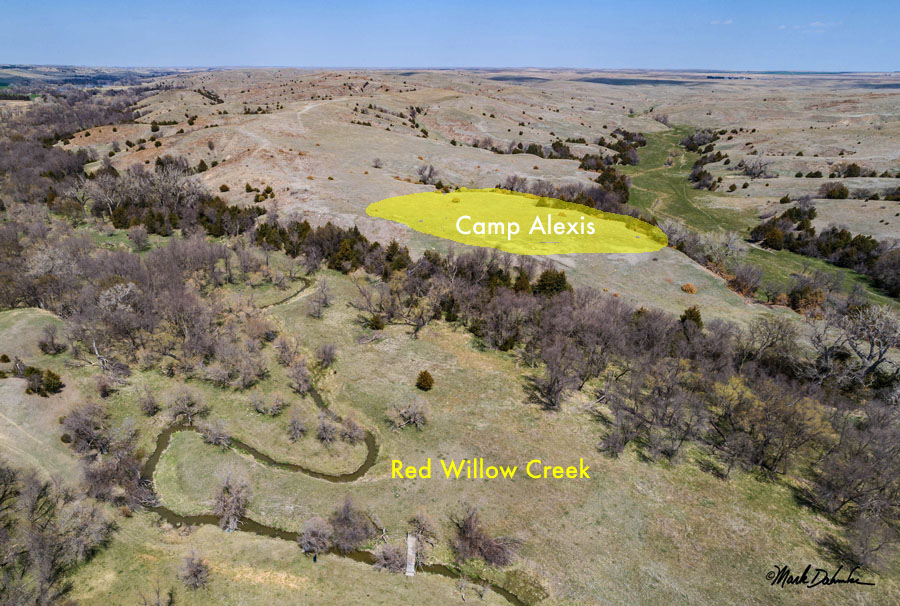
Hey All…
I wanted to quickly share with you a couple images from our journey to the site of Camp Alexis in Hayes County, Nebraska. I will, of course, be posted many others, but I wanted to give you a preview of what we saw and experienced. By 'we' I refer to my companions: pilot and pioneer descendant Dave Ott and expert drone pilot and videographer, Mark Dahmke. Yesterday we met up in North Platte and caravanned in two vehicles over 80 miles south to the property of the Mintling family, who have homesteaded the site since the 1870s.
John Mintling escorted us across his newly sprouted winter wheat field to the edge of a ravine through which flows Red Willow Creek. He explained how we reached the site of the encampment. Fortunately, Mark had a better sense of the location than I did and we soon found ourselves standing on the site of the encampment of January 1872 at which the U.S. Army and Spotted Tail's Lakota "entertained" Grand Duke Alexis, the fourth son of Tsar Alexander II of Russia, to three days of high adventure.
Mark and his JDL drone took amazing video of the site, one panoramic image of which I've attached below highlighting the location of the encampment and Red Willow Creek. Additionally, the URL link Mark provided leads to an amazingly detailed 360 degree panorama of the site from several hundred feet in altitude.
https://www.markdahmke.photography/panos/viewer/krpano.html?xml=../camp1872/camp1872.xml
I have to be honest with you and say that you can study a site in detail from aerial and satellite imagery, but there is nothing like being there on the ground and getting a real sense of the topography, the vegetation, and just the general lay of the land. Importantly, all three of us commented about what if we could step through a time portal back to 1872 and experience what it was like then without airline contrails, and invasive species like red cedar, and buffalo as far as the eye can see. In a way that is what I am hoping to accomplish through the CAMP 1872 Xperience.
Thanks to Mark and Dave and John we now have the ground data to create such an experience.
Bill
NOTE # 23: Bison Calf Weight Problem Solved: With a Little Help From a Friend
PUBLISHED:2021-05-02
REFERENCE URL:
Excited this morning. See the attached DB table. It shows the "virtual/digital" calves born so far to the Alpha bison herd this calving season (April-May). The last several calves where programmatically "born" by an algorithm, including the most recent, #34.
With the help of wake689 on Sitepoint, my problem with randomly updating their weight on a daily basis has been solved. Here's the code he/she suggested that scrunches multiple lines of code that I wrote (and didn't work) into one concise UPDATE that does.
UPDATE animals SET weight=weight+((RAND()*0.4)+1.5) WHERE DATEDIFF(CURDATE(), bdate) <366
What also I find interesting about the table is the ratio of females 3-to-1 over males. The gender is selected randomly by the algorithm, so you'd think the ratio would be 1-to-1: 50% male, 50% female, but it isn't. Most curious... but also beneficial to the growth of the herd: more females mean more calves born in the future.

NOTE # 22: Dainty Hands and Buf'lo 'Chips'
PUBLISHED:2021-05-01
REFERENCE URL:https://history.nebraska.gov/publications/buffalo-and-cow-chips
Once you get west of the Missouri River, wood becomes increasingly scarce, except for the odd cottonwood along stream beds. This paucity led to native tribes and pioneer/immigrant settlers utilizing dried bison manure "chips" as a cooking fire and heat source, which led to the penning of the following verse poetically describing the reaction of young women to handling it.
Over the sun-kissed prairie swells
She strayed in her youthful grace.
The wind-blown tresses of auburn hair
Half-hid her bewitching face.
Her gathered apron, one slim hand held,
As she scanned each tuft with care.
And oft and again she lithely stooped
To place her treasure there."O maiden fair, what seekest thou?
Pale lily, rose divine
Or the shy, sweet buds of the violet?"
She lifted her eyes to mine.
And then the answer, soft and clear
Fell ripe from her coral lips,
"Stranger, there hain't no posies here-
I'm lookin' fer buf'lo chips!"
NOTE # 21: First Official Virtual Bison Calf Birth
PUBLISHED:2021-04-21
REFERENCE URL:
Below is email notification moments ago of the first virtual birth of bison calf number A20210421F0029 to the "Little Big Buffalo Hunt" alpha herd. The "birth" was programmed to take place on April 21st as part of an algorithm to create a digital herd that will be part of the proposed Augmented Reality geolocation game. Most bison calves are born after a 9 1/2 month gestation period in April and May.

NOTE # 20: Drone Video of Camp Alexis Site
PUBLISHED:2021-04-21
REFERENCE URL:
On April 24, 2021, Spirit Airline pilot Dave Ott and project originator Bill Moore are flying to North Platte, NE to meet up with licensed drone operator Mark Dahmke to drive down to the site of Camp Alexis hunting camp in January 1872. There we will meet with the land owner and plan to video the campsite using conventional video and drone footage based on the location originally identified by the UNL site survey of 2008-09. Below is the proposed drone flight grid based on the UNL estimation of the US Army camp published in Custer, Cody, and Grand Duke Alexis - Historical Archaeology of the Royal Buffalo Hunt by Scott, Bleed and Damm.
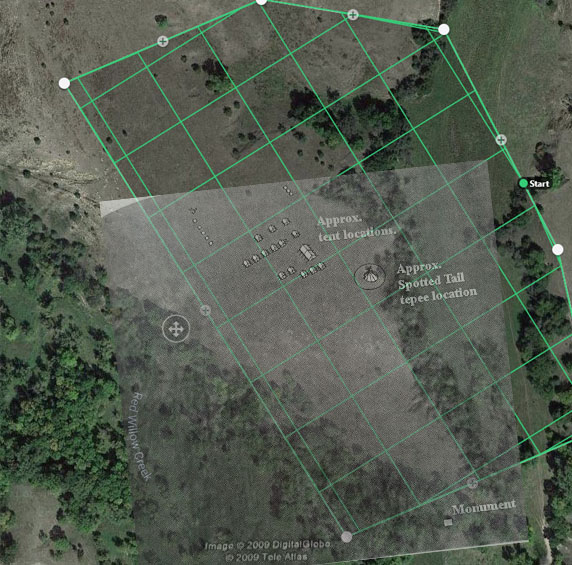
NOTE # 19: How Gray Wolves Survived the Pleistocene
PUBLISHED:2021-04-17
REFERENCE URL:https://www.sciencealert.com/wolves-used-this-one-weird-trick-to-survive-the-last-ice-age
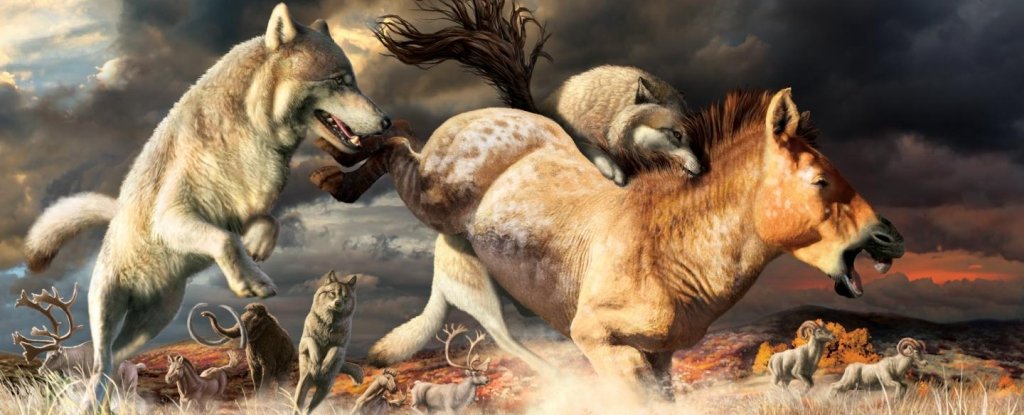
It was recently announced that there's been a new sighting of a gray wolf in Nebraska. With the extinction of the large cats and the Dire Wolf in the Pleistocene, the question has been asked: How did gray wolves survive? Apparently, the story is in their teeth: isotopes indicate that their primary prey were the small pre-historic horses that once roamed the Great Plains tens of thousands of years ago. They had other prey, of course, but the little Equus sp. was their favorite.
"Around 50 percent of their diet, this analysis found, was an extinct species of Pleistocene horse (Equus sp.). The rest was a mixture of muskox (Ovibos moschatus), Dall sheep (Ovis dalli), and reindeer (Rangifer tarandus), with a little bit of woolly mammoth (Mammuthus primigenius)."I wonder why bison were not included? Hmmm.
NOTE # 18: Song of the Plains - Famous Melody, But Composed in 1933
PUBLISHED:2021-04-17
REFERENCE URL:https://www.youtube.com/watch?v=qNBSetc9nNQ
I came across this Youtube video entitled "Song of the Plains" and thought it might be appropriate for the "Ghosts of the Buffalo Grass" production since the 1872 event brought Russian military representatives together with US Cavalry and Lakota warriors, the latter considered some of the best mounted fighters in the world. You'll recognize the tune. However, when I researched when it was written, it was in 1933! The lyrics were the give-away referring to "our tanks" and "Red Army." Unlike the imperial Russian "God Save the Czar," which was written in the mid-1800s, having music from the Soviet era wouldn't seem appropriate.
NOTE # 17: The Western Prairies: A Poetic View from 1840
PUBLISHED:2021-04-14
REFERENCE URL:https://chroniclingamerica.loc.gov/data/batches/vi_aquasox_ver01/data/sn85025007/00414215683/1840091601/0092.pdf
I came across this poem in the September 16, 1840 issue of the Alexandria Gazette. Deciphering it from a Library of Congress scan took a bit of work, but I found it intriguing in its pre-expansionist perspective. The war with Mexico was 8 years away. Gold had not yet been discovered in California. Mainly fur traders ventured into this ocean of grass. Fascinating is the reference to the long-gone Mound Builders as seen in almost Homeric terms and the depiction of the invading red man, to be followed by inevitable tide of Sabbath keepers. Enjoy.
WEDNESDAY MORNING, Sept. 16, 1840.
THE WESTERN PRAIRIES.
By BRYANT.
These are the Gardens of the Desert, these
The unshorn fields, boundless and beautiful,
For which the speech of England has no name:
The Prairies. I behold them for the first.
And mv heart swells, while the dilated sight
Takes’ in the encircling vastness. Lo they stretch
In airy undulations, far away,
As if the ocean, in his gentlest swell,
Stood still, with all his rounded billows fixed,
And motionless forever. — Motionless?—
No—they are unchained again. The clouds
Sweep over with their shadows, and beneath,
The surface rolls and fluctuates to the eye;
Dark hollows seem to glide along and chase
The sunny ridges. Breezes of the South!
Who toss the golden and the flame-like flowers
And pass the prairie hawk that poised on high
Flaps his broad wings, yet moves not—yet
have played
Among the palms of Mexico, and vines
Of Texas, and have crisped the limpid brooks
Tint from the fountains ot Sonora glide
Into the calm Pacific—have ye fanned
A nobler or a lovelier scene than this?
Man hath no part in all this glorious work:
The Hand that built the firmament hath heaved
And smoothed these verdant swells, and sown
their slopes
With herbage, planted them with island
groves
And hedged them round with forests. Fitting
floor
For this magnificent temple of the sky—
With flowers whose glory and whose multitude
Rival the constellations! The great heavens
Seem to stoop down upon the scene in love—
A nearer vault, and of a tender blue
Than that which bends above the eastern hills.
As o'er the verdant waste I guide my steed
Among the high rank grass that sweeps his
sides,
The hollow beating of his footstep seems
A sacrilegious sound. I think of those
Upon whose rest he tramples. Are they here
The dead of other days?—and did the dust
Of these fair solitudes once stir with life,
And burn with passion? Let the mighty
mounds
That overlook the rivers, or that rise
In the dim forest crowded with old oaks,
Answer. A race that long has passed a way,
Built them:—a disciplined and populous race
Heaped with long toil, the earth, while yet the
Greek
Was hewing the Pentelicus to forms
Of symmetry, and rearing on its rock
The glittering Parthenon. These ample fields
Nourished their harvests, here their herds
were led,
When haply by their stalls the bison lowed,
And bowed his maned shoulder to the yoke.
All day this desert murmured with their toils,
'Till twilight blushed and lovers walked and
wooed
In a forgotten language, and old tunes,
From instruments of unremembered form,
Five the soft winds a voice. The red man
came—
the roaming hunter tribes, warlike and fierce
And the mound-builders vanished from the
earth.
The solitude of centuries untold
as settled where they dwelt. The prairie
wolf
Hunts in their meadows, and his fresh dug
den
Yawns By my path. The gophor mines the
ground
Where stood their swarming cities, All is
gone,
All save the piles or earth that hold their
bones—
platforms where they worshipped unknown gods—
The barriers which they builded from the soil
To keep the foe at bay—till o’er the walls
the wild beleaguerers broke, and, one by one
The strong-holds of the plain were forced and
heaped
With corpses. The brown vultures of the
wood
Flocked to those vast uncovered sepulchres,
And sat, unscared and silent, at their feast.
Hapiy some solitiary fugitive,
Lurking in marsh and forest, till the sense
desolation and of tear became
Bitterer than death, yielded himself to die.
Man's better nature triumphed. Kindly words
Welcomed and soothed him; the rude conquerors
Seated their captive with their chiefs; he chose
bride among their maidens, and at length
Seemed to forget—yet ne’er forgot—the wife
his first love, and her sweet little ones,
Butchered, amid theirshrieks, with all his race.
Thus change the forms of being. Thus arise
Races of living things, glorious in strength,
And perish, as the quickening breath of God
Fills them, or is withdrawn. The red man too
Has left the blooming wilds he ranged so long,
And nearer to the Rocky mountains, sought
a wider hunting ground. The beaver builds
On waters whose blue surface ne’er gave back
The white man's face: among Missouri springs
And pools whose issues swell the Oregon,
He rears his little Venice. In these plains
the bison feeds no more. Twice twenty
leagues
Beyond remotest smoke of hunter’s camp,
Roams the majestic brute, in herds that shake
the earth with thundering steps—yet here I
meet
His ancient footprints stamped beside the pool.
Still this great solitude is quick with life,
Myriads of insects,gaudy as the flowers
They flutter over, gentle quadrupeds,
And birds that scarce have learned the fear
of man,
And here, and sliding reptiles of the ground.
Startingly beautiful. The graceful deer
Bounds to the wood at my approach. The bee
A more adventurous colonist than man,
With whom he came across the eastern deep,
Fills savannas with his murmurings,
And hides hisweets, as in the golden age,
Within the hollow tree. I listen long
His domestic hum, and think I hear
The sound of that advancing multitude
Which soon shall fill these deserts. From
the ground
Comes up the laugh of children, the soft voice
Of maidens. and the sweet solemn hymn
Of Sabbath-worshippers. The low of herds
Blends with the rustling of the heavy grainOver the dark brown furrows. All at once
A fresher wind sweeps by and breaks my
dream
And I am in the wilderness alone.NOTE # 16: Building a Digital Bison Herd : Grazing Range Conditions
PUBLISHED:2021-04-14
REFERENCE URL:https://droughtmonitor.unl.edu/One of the most important factors affecting the lifecycle of grazing ungulates like bison is the condition of the grasslands on which they depend. The map below is a compilation of the Koppen-Geiger land-type map over which is superimposed the USDA and UNL's drought mitigation map for April 2021. Historically, the largest bison herds occupied the central Great Plains (orange and tan regions on the map). Drought conditions persist in the northern (North Dakota) range. This would impact the condition of wild bison herds in that region.
We propose to use this data to control the birth rate and growth rate of our digital bison NFTs.
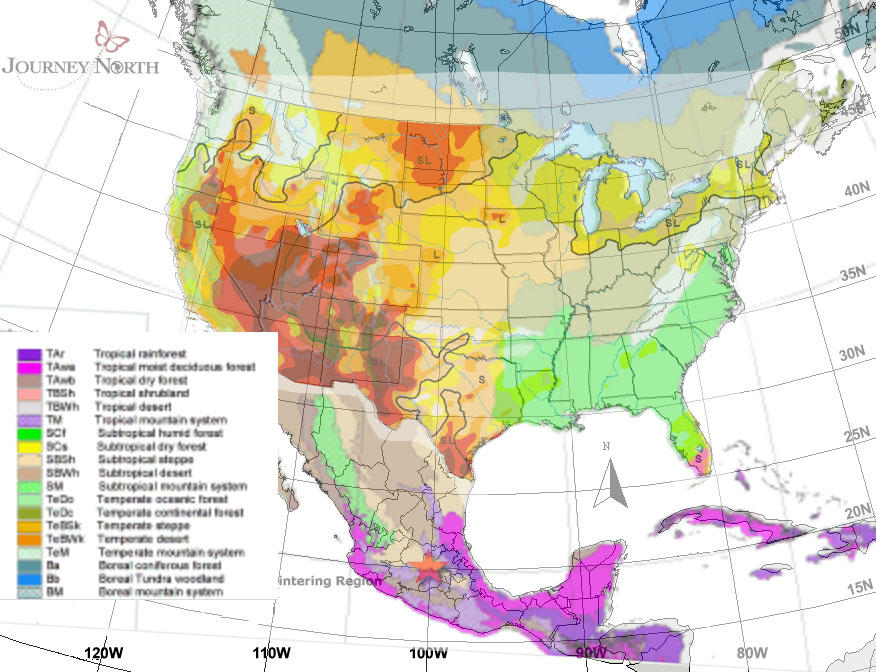
NOTE # 15: NOAA Climate Maps
PUBLISHED:2021-04-13
REFERENCE URL:https://www.ncdc.noaa.gov/temp-and-precip/us-maps/1/202103?products[]=countypcpnrank#us-maps-selectThe idea of creating digital bison with tradable value pegged to cryptocurrency blockchain NFTs (non-fungible tokens) requires that the NFT's value is not just tied to market demand but also to the virtual health of the "bison", which like real their real-life counterparts, is also tied to their physiological development. This development is bound to the condition of the pastures on which they graze, which is classed by the Bison Producers of Alberta (https://www.bisoncentre.com/resources/resource-library/advanced-bison-information-producers/pasture-management/setting-stocking-rates-pastures/) as "Excellent, Good, Fair, Poor." This classification is based on the percentage of "adapted grasses and legumes," which in turn is dependent on annual precipitation. NOAA provides a monthly database of precipitation rates as seen in the attached map for March 2021. While ascertaining the quality of pasturage by county may not be possible, rainfall could serve as an interim analog: the more rain, the better the overall quality of the pasturage.

NOTE # 14: How to Make Pemmican: Native People's Survival Food
PUBLISHED:2021-04-13
REFERENCE URL:https://en.wikipedia.org/wiki/PemmicanWithout refrigeration or readily available salt, this is how the Plains tribes reserved the bison and other wildlife they killed. The meat had to be cut up, pulverized, air or fire dried, crushed into a course powder and mixed with suet (and wild berries in season). Once prepared, it could last months. Note that in one US Army raid on an Native camp in winter during "Red Cloud's War" in the last 1860s, the troops not only burned all the lodges, each made up of as many as a dozen or more bison skins, but a reported 30 tons of pemmican!
NOTE # 13: Siberia's Pleistocene Park: Bringing back pieces of the Ice Age to combat climate change
PUBLISHED:2021-04-12
REFERENCE URL:https://cbsn.ws/34ZhuTsNOTE # 12: The Plan to Revive the Mammoth Steppe to Fight Climate Change
PUBLISHED:2021-04-12
REFERENCE URL:https://www.patreon.com/PleistoceneParkNOTE # 11: European Trade and Native Living Standards
PUBLISHED:2021-04-12
REFERENCE URL:http://www.economichistory.ca/pdfs/2012/carlos-lewis.pdfRichard Steckel and Joseph Prince argue that the traditional native economy made possible a biological standard of living higher than in Europe. The Indians of the Great Plains, including 67 the Assiniboin, who lived much of the year in the boreal forest south of Hudson Bay, were among the “tallest in the world,” a clear indication that they were better nourished. Health-based measures are one approach to living standards, but a comprehensive method requires that we take account of all consumption. In the case of the natives of the Hudson Bay region this includes the variety of goods they obtained through trade.
The great advantage of Native Americans over Europeans in nutrition is illustrated in Table 3, which compares the diets of low-wage English workers in the mid-eighteenth century with the diets of natives of the boreal forest. Daily caloric intake was much greater, 3,500 kcal versus 2,500 kcal for adult males, but the gap is a reflection of different energy demands. More revealing is the composition of the diets. On account of the greater meat component, natives consumed was much more protein, close to 500 grams per day versus 100 grams per day by the English. English workers derived just 5 percent of their calories from meat, 14 percent if dairy products are included. Their diet was mainly grain-based. By contrast, Native Americans obtained nearly all their calories from meat and fish, and most of that came from the flesh of large ungulates, the highest-priced type of food in Europe. This means that a measure of living standards based on food gives natives a decided advantage.
Native clothing, which was made from animal skins that were often decorated, was superior to the low-quality cloth worn by English workers. Budget studies reveal that the cost of English workers’ clothing was far less than the value of the deer, caribou, beaver, and other skins that were used in native clothing. On the other hand, natives, because of their nomadic lifestyle, had inferior housing; living in tipis or wigwams in the winter and communal log houses in the summer. And despite the volume of luxury goods they received from the fur trade, native purchases of luxuries, especially alcohol, was much less. Arriving at an overall comparison of living standards requires weighting the categories of consumption goods. Weights can be derived from the choices of these eighteenth-century consumers. Where weights corresponding to English budgets are used, natives in the Hudson Bay region are derived to have real incomes between 10 and 25 percent less than English workers. But if native weights are used, the positions are reversed. The real income of natives is 10 to 20 percent higher. The implication is that in the mid-eighteenth century Native Americans and low-wage English workers had similar standards of living. It was only later that the relative position of natives declined.
SOURCE: "Exchange among Native Americans and Europeans before 1800 Strategies and Interactions"
NOTE # 10: The Last of the Romanovs | Grand Duchess Olga Alexandrovna
PUBLISHED:2021-04-10
REFERENCE URL:The extraordinary story of Tsar Nicholas' sister and her journey from the palaces of St. Petersburg to death in obscurity above a barbershop in Toronto.
NOTE # 9: Food traceability: The Beefchain Blockchain Solution
PUBLISHED:2021-04-09
REFERENCE URL:https://www.crypto-news-flash.com/cardano-based-beefchain-is-tested-on-1600-calves-in-wyoming/amp/Wyoming ranchers using blockchain to secure their product chain. These could provide insights and guidance for the digital bison analog NFTs.
NOTE # 8: Google’s new AR experiment conjures portals to the other side of the planet
PUBLISHED:2021-04-09
REFERENCE URL:https://thenextweb.com/plugged/2021/04/08/googles-new-ar-experiment-conjures-portals-to-the-other-side-of-the-planet/Google's new experiment called Floom creates vortexes in your room that'll let you see what's on the other side of the globe, literally.
Here's how it works. Head to the Floom site in Chromeon your Android device. After approving necessary permissions, point your camera to an empty space on the floor. You might need to walk around a bit for it to work.NOTE # 7: REWILD: Grasslands
PUBLISHED:2021-04-09
REFERENCE URL:https://play.google.com/store/apps/details?id=com.PHORIA.RewildAtHomeREWILD is an immersive AR nature experience, brought to you by Netflix, PHORIA & Google, featuring stunning scenes from the Netflix original documentary series 'Our Planet'.
NOTE # 6: CPU algorithm trains deep neural nets up to 15 times faster than top GPU trainers
PUBLISHED:2021-04-09
REFERENCE URL:https://techxplore.com/news/2021-04-rice-intel-optimize-ai-commodity.htmlXperience includes conversational 'immersive agents', AKA chatbot avatars of the lead characters, basically 3D holograms and AR projections with whom you could carry on a conversation.
"The whole industry is fixated on one kind of improvement—faster matrix multiplications," Shrivastava said. "Everyone is looking at specialized hardware and architectures to push matrix multiplication. People are now even talking about having specialized hardware-software stacks for specific kinds of deep learning. Instead of taking an expensive algorithm and throwing the whole world of system optimization at it, I'm saying, 'Let's revisit the algorithm.'"NOTE # 5: Primitive Bison Hunting with the Atlatl & Exploring Experimental Archaeology
PUBLISHED:2021-04-08
REFERENCE URL:https://www.youtube.com/watch?v=l7jMxfopKjM47-minute documentary on the hunt and killing of bison using primitive, stone age weapons.
NOTE # 4: 19th Century Union Station, Omaha, NE
PUBLISHED:2021-04-06
REFERENCE URL:Union Pacific station in Omaha between 1870-1930. The current station, now the Durham Museum, was built over the old station starting in 1930.
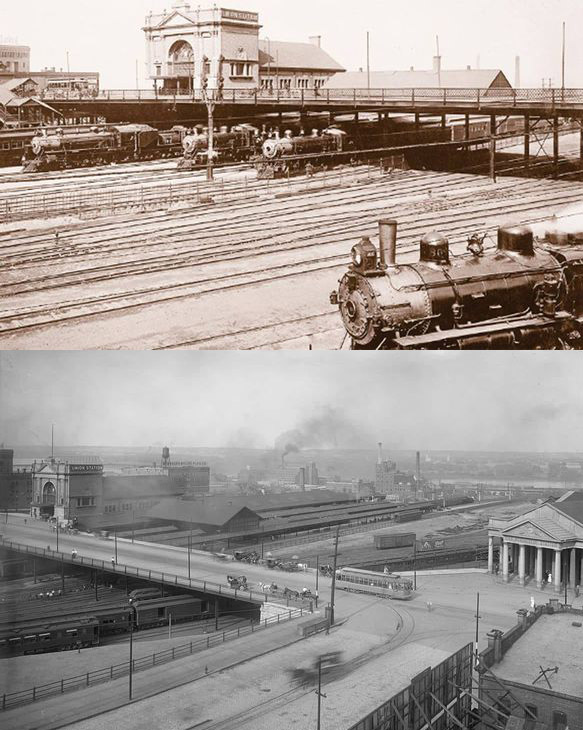
NOTE # 3: Buffalo Wives: The Women Who Helped Save America's Bison
PUBLISHED:2021-04-06
REFERENCE URL:https://bisoncentral.com/genetic-item/the-early-days-ranchers-role-in-bison-restoration/Mollie Goodnight • Agathe Finley Pablo • Louise Allard • Sarah Laribee Philip • Mary Good Elk Woman Dupree • Mary Sabine Walking Coyote

NOTE # 2: The Buffalo Grass of the Great Plains
PUBLISHED:2021-04-06
REFERENCE URL:https://www.gutenberg.org/files/17748/17748-h/17748-h.htmBouteloua oligostachya : aka. Buffalo Grass. This from Wm Hornaday "THE EXTERMINATION OF THE AMERICAN BISON"
VI. The Food of the Bison.
It is obviously impossible to enumerate all the grasses which served the bison as food on his native heath without presenting a complete list of all the plants of that order found in a given region; but it is at least desirable to know which of the grasses of the great pasture region were his favorite and most common food. It was the nutritious character and marvelous abundance of his food supply which enabled the bison to exist in such absolutely countless numbers as characterized his occupancy of the great plains. The following list comprises the grasses which were the bison's principal food, named in the order of their importance:[Pg 427]Bouteloua oligostachya (buffalo, grama, or mesquite grass).—This remarkable grass formed the pièce de résistance of the bison's bill of fare in the days when he flourished, and it now comes to us daily in the form of beef produced of primest quality and in greatest quantity on what was until recently the great buffalo range. This grass is the most abundant and widely distributed species to be found in the great pasture region between the eastern slope of the Rocky Mountains and the nineteenth degree of west longitude. It is the principal grass of the plains from Texas to the British Possessions, and even in the latter territory it is quite conspicuous. To any one but a botanist its first acquaintance means a surprise. Its name and fame lead the unacquainted to expect a grass which is tall, rank, and full of "fodder,"like the "blue joint"(Andropogon provincialis). The grama grass is very short, the leaves being usually not more than 2 or 3 inches in length and crowded together at the base of the stems. The flower stalk is about a foot in height, but on grazed lands are eaten off and but seldom seen. The leaves are narrow and inclined to curl, and lie close to the ground. Instead of developing a continuous growth, this grass grows in small, irregular patches, usually about the size of a man's hand, with narrow strips of perfectly bare ground between them. The grass curls closely upon the ground, in a woolly carpet or cushion, greatly resembling a layer of Florida moss. Even in spring-time it never shows more color than a tint of palest green, and the landscape which is dependent upon this grass for color is never more than "a gray and melancholy waste."Unlike the soft, juicy, and succulent grasses of the well-watered portions of the United States, the tiny leaves of the grama grass are hard, stiff, and dry. I have often noticed that in grazing neither cattle nor horses are able to bite off the blades, but instead each leaf is pulled out of the tuft, seemingly by its root.
Notwithstanding its dry and uninviting appearance, this grass is highly nutritious, and its fat-producing qualities are unexcelled. The heat of summer dries it up effectually without destroying its nutritive elements, and it becomes for the remainder of the year excellent hay, cured on its own roots. It affords good grazing all the year round, save in winter, when it is covered with snow, and even then, if the snow is not too deep, the buffaloes, cattle, and horses paw down through it to reach the grass, or else repair to wind-swept ridges and hill-tops, where the snow has been blown off and left the grass partly exposed. Stock prefer it to all the other grasses of the plains.
On bottom-lands, where moisture is abundant, this grass develops much more luxuriantly, growing in a close mass, and often to a height of a foot or more, if not grazed down, when it is cut for hay, and sometimes yields 1½ tons to the acre. In Montana and the north it is generally known as "buffalo-grass,"a name to which it would seem to be fully entitled, notwithstanding the fact that this name is also applied, and quite generally, to another species, the next to be noticed.
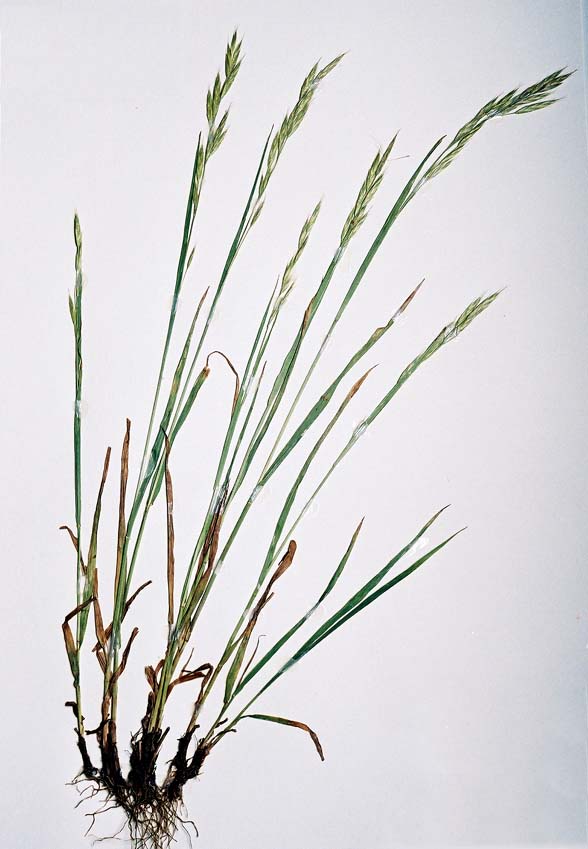
NOTE # 1: The Buffalo on the 1913 Indian Head Nickel
PUBLISHED:2021-04-06
REFERENCE URL:https://allaboutbison.com/buffalo-nickel/Ever found one of these? The Indian Head Five Cents piece (US Nickel). Here is the story of the bison bull on the reverse side.


